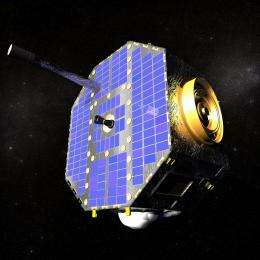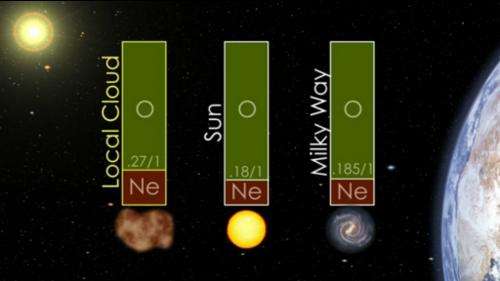IBEX spacecraft measures 'alien' particles from outside solar system

(PhysOrg.com) -- Using data from NASA's Interstellar Boundary Explorer (IBEX) spacecraft, an international team of researchers has measured neutral "alien" particles entering our solar system from interstellar space. A suite of studies published in the Astrophysical Journal provide a first look at the constituents of the interstellar medium, the matter between star systems, and how they interact with our heliosphere.
The heliosphere, the "bubble" in which our Sun and planets reside, is formed by the interaction between the solar wind, flowing outward from the Sun, and the interstellar medium, which presses up against it. Electrically charged, or ionized, particles cannot penetrate the boundary between these two bodies. However, neutral particles, which make up about half the material outside the heliosphere, flow freely in through the boundary.
The only other spacecraft to directly detect these inflowing neutral particles was Ulysses, which more than a decade ago measured interstellar neutral helium. Although IBEX is designed primarily to map the interactions between the solar wind and ionized interstellar material, its low-energy energetic neutral atom camera has now also measured interstellar neutral particles not detected by Ulysses. From its location within Earth's orbit, IBEX has sampled interstellar hydrogen, oxygen, and neon in addition to neutral helium.

Neon and oxygen reside throughout the galaxy, but researchers are unsure of their distribution. Using IBEX data, the first direct measurements of these elements in the local interstellar medium, researchers can determine how much oxygen is in the local part of the galaxy, which materials are present in what amounts and more.
"Answering these questions is important for understanding the variability of the galactic soup — the material from which stars, planets and life all form," says Dr. David J. McComas, IBEX principal investigator and an assistant vice president at Southwest Research Institute.
For example, the presence of less oxygen in the local interstellar medium compared to the Sun and galactic average could indicate the Sun formed in a region with less oxygen than exists in its current location. Another possibility is that the oxygen could be preferentially tied up or "hidden" in other galactic materials, such as dust grains and ices.
IBEX data reveal that interstellar neutrals enter the heliosphere at a speed of about 52,000 mph, roughly, 7,000 mph slower than inferred from Ulysses observations, and that they enter from a somewhat different direction. Magnetic forces play a major role in the interactions of the charged particles at the heliosphere's boundaries. As the overall particle speeds drop, however, the magnetic forces play an even more dominant role.

"With this lower speed, the external magnetic forces cause the heliosphere to become more squished and misshapen," says McComas. "Rather than being shaped like a bullet moving through the air, the heliosphere becomes flattened, more like a beach ball being squeezed when someone sits on it."
Based on the older Ulysses data, researchers had theorized that the heliosphere was leaving the local galactic cloud and transitioning into a new region of space. However, while the boundary is very close, IBEX results show the heliosphere remains fully in the local cloud, at least for the moment.
"Sometime in the next hundred to few thousand years, the blink of an eye on the timescales of the galaxy, our heliosphere should leave the local interstellar cloud and encounter a much different galactic environment," McComas says.
Researchers will be able to add measurements about the charged particles outside the heliosphere to the neutral particle measurements provided by IBEX as the two Voyager spacecraft leave our solar system and cross the heliopause, possibly within the next few years.
"That will give us an even more complete picture of what's happening in the regions surrounding our home in the solar system," says McComas.
The six papers detailing the new IBEX results and an editorial written by McComas were published today in a Special Supplements issue of the Astrophysical Journal called "Interstellar Boundary Explorer (IBEX): Direct Sampling of the Interstellar Medium." The authors represent an international team of researchers from Southwest Research Institute, the University of Bern, Switzerland, the Polish Academy of Sciences Space Research Centre, the University of New Hampshire, the University of Chicago and the Massachusetts Institute of Technology.
IBEX is the latest in NASA's series of low-cost, rapidly developed Small Explorer space missions. Southwest Research Institute in San Antonio leads and developed the mission with a team of national and international partners. NASA's Goddard Space Flight Center in Greenbelt, Md., manages the Explorers Program for NASA's Science Mission Directorate in Washington.
Provided by Southwest Research Institute



















